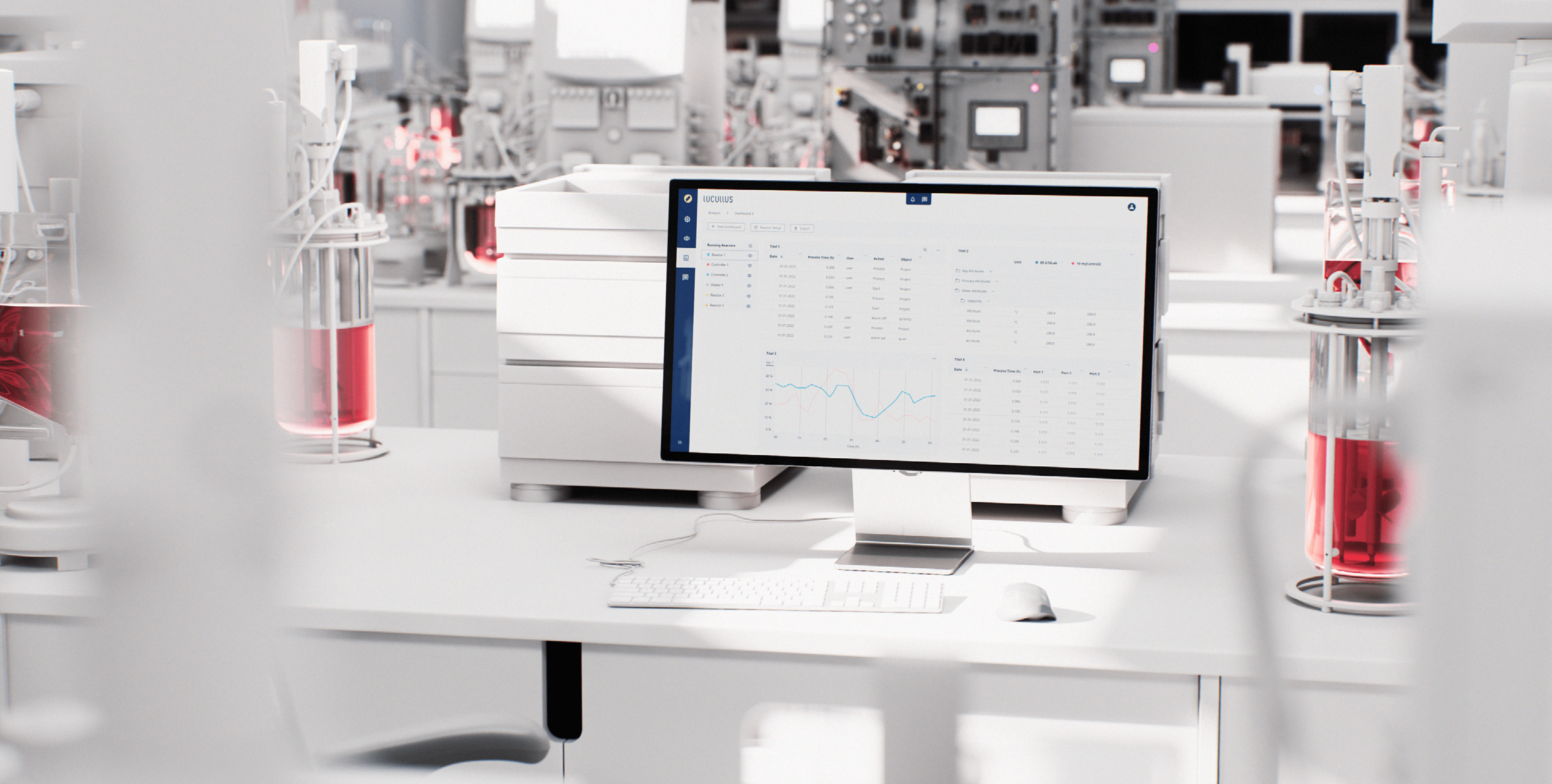Introduction
The digital transformation of biomanufacturing processes – commonly referred to as “Bioprocessing 4.0” – imagines holistically interconnected and automated bioprocess equipment. In Bioprocessing 4.0 production concepts, biomanufacturing processes are run, monitored, controlled, and significantly improved in robustness through the implementation of dynamic feedback loops and mathematical modeling approaches (Bisschops & Cameron, 2022). Despite Bioprocessing 4.0 production concepts’ promise of better process consistency with improved quality and safety for biologics, many biopharmaceutical companies still struggle to implement 4.0 production concepts and do not exploit the full potential offered by the digitalization and automation of biomanufacturing processes (Kopec & Arsénio, 2020).
Lucullus®, Securecell’s process information management system, is a versatile solution designed to address digital transformation of biomanufacturing processes. By being vendor-agnostic and holistic, Lucullus® empowers connectivity and communication across many different devices and software solutions commonly found in bioprocessing laboratories. This facilitates the integration of these diverse components to realize overarching data integration and process harmonization. The Lucullus® process control recipes are the foundation for the execution of automated and dynamic feedback loops. In Lucullus®, process control recipes are created through the assembly of interconnected command blocks, so-called step chains, that allow for event-based process control (Figure 1).

in the application note titled “Getting a grip on oxygen transfer in bioreactors: Automated kLa determination using the software Lucullus” available on the Securecell website: https://www.securecell.ch/insights/ automated-kla-determination-using-the-software-lucullus.
The requirements for automated process control recipes differ depending on the phase of the biomanufacturing process. In R&D and process development (PD), for example, bioprocesses need to be established, meaning that a lot of different instrument configurations and process conditions need to be tested. This requires a high degree of flexibility for creating process control recipes. In contrast, in manufacturing optimal instrument configurations and process conditions are already well defined. In this case, the process control recipe must be rigid to support reproducibility and consistent product quality, and all changes need to be logged and protected by appropriate user management tools.
In this article, we present a modular master operation for bioprocesses using the software Lucullus®. The master operation can be applied to various cultivation settings within the same bioreactor system and can be easily transferred to other reactor systems and brands. This has the advantage that only a single process control recipe is required to effectively cover the entire spectrum of cultivations. In the realm of manufacturing, the processes are established, optimized, and tested and the previously modular process control recipes can be adjusted into rigid and fully automated configurations, primed for the validation process.
Results and Discussion
Bioprocesses can be thought of as timed sequence of distinct process phases. Generally, after an initial preparation phase, inoculation is performed, followed by a batch phase to expand biomass. Afterward, the process phases vary based on the process type, but the most often used phases would be feeding and bleeding phases, slow or swift shifts of process parameters such as temperature or pH, or harvest phases for product recovery during semi-continuous processes.
Figure 2 shows the outline of an exemplary Lucullus® master operation. The yellow steps are so-called automated steps, while the blue steps are manual steps. The automated steps do not require any operator input and transition when certain transition criteria are fulfilled, while manual steps require an operator input for the transition. After the process starts, which includes an inoculation and a batch phase, a manual selection step follows, where the operator selects one of the multiple process phases. After the selected process phase is finished, the process control recipe returns to the initial selection step. In this way, operators can easily select which phases to use and which to omit, being able to mix and match steps to create their process on the fly based on their results from the previous process phases. When processes are more established, the selection step can also be automated, and different phases are automatically selected based on process parameter values and events, allowing users to benefit from dynamic event-based process control options.

Figure 3A shows pO2 values during the different process phases of a Pichia pastoris cultivation for protein production using the master operation described before (Figure 2). The P. pastoris cultivation consists of five distinct phases:
1. An initial batch phase
2. A high growth-rate glycerol feeding phase to increase biomass
3. A temperature shift to a lower temperature
4. A methanol feed pulse for metabolic adaptation of cells to the new substrate
5. A low growth rate feeding phase with methanol for product formation
Figure 3B depicts the path through the master operation. Each time the step chain returns to the “Selection Step”, the operator has the flexibility to choose the subsequent path and define the process conditions for that specific path accordingly.

displayed as bars. On the right side, the path through the different process control steps is visualized. Steps that are not entered are depicted with reduced opacity. The four loops through the process control recipe after the batch phase are marked 2 to 5.
Figure 4A depicts pO2 values during the different process phases of an Escherichia coli cultivation for veterinary vaccine production using the same master operation (Figure 2). The E. coli cultivation consists of five distinct phases:
1. An initial batch phase
2. A partial harvest phase
3. A feed phase with glycerol
4. Another partial harvest phase
5. A feed phase with glycerol
Figure 4B depicts the path through the master operation. As for the P. pastoris cultivation, the same master operation is used and each time the step chain returns to the “Selection Step,” the operator has the flexibility to choose the subsequent path and define the process conditions for that specific path accordingly.

Although the processes differ in the organisms used, the overall process strategies, and the process goals, the same master operation can be applied. All processes are performed and annotated identically which increases data consistency and reduces time for data preprocessing, as data format heterogeneity is a big challenge in data science (Shi et al., 2019). Consequently, the same basic automated analysis routines can be used for information extraction such as yields and growth rates. Once a process is established in an R&D or PD environment, the manual transition steps can be replaced by automated ones, and the process can be seamlessly transferred to the pilot and production environment. Furthermore, using a single master operation offers the advantage of reduced maintenance
through increased usability which is a well-known impact in software development (Mari & Eila, 2003). To give an example: If a reactor is refitted with new equipment that requires changes in the process control recipe, only one recipe needs to be updated instead of numerous process control recipes for different processes.
Conclusion
Conception and validation of a process control recipe is time intensive and requires in-depth understanding of the bioprocess and the connected equipment. In addition, the diversity of cultivations involving distinct organisms normally requires a unique process control recipe for each combination of bioreactor and organism. In this article, we presented a modular and flexible master operation for bioprocesses using the software Lucullus®. The master operation can be used in different cultivation settings on the same reactor system or even on different reactor systems thanks to a powerful naming convention in the background. This has the advantage that only one process control recipe is necessary to effectively encompass the entire spectrum of cultivations. The thoroughly tested master step chains can be turned into rigid and fully automated step chains and can thereafter be seamlessly validated in a GMP environment and production setting.
Key Results
-
Master operations consist of a selection step, branching into the permittable phases (feeding, pH shift, temperature shift, etc.), and afterward returning to the selection step
-
Master operations allow for high flexibility for research and development laboratories with different processes, or where cultivation strategies are still in development
-
Single master operations can increase efficiency by cutting time for training, reducing maintenance, and streamlining data analysis workflows
-
The first variable and manual master operation can be made rigid and automated for use in production and validated environments
References
- Bisschops, M., & Cameron, L. (2022). Process Intensification and Industry 4.0: Mutually Enabling Trends. Process control, intensification, and digitalisation in continuous biomanufacturing, 209-229.
- Shi, P., Cui, Y., Xu, K., Zhang, M., & Ding, L. (2019). Data consistency theory and case study for scientific big data. Information, 10(4), 137.
- Demesmaeker, M., Kopec, D., & Arsénio, A. M. (2020). Bioprocessing 4.0–Where Are We with Smart Manufacturing
in 2020?. Pharmaceutical Outsourcing. - Mari, & Eila. (2003). The impact of maintainability on component-based software systems. In 2003 Proceedings
29th Euromicro Conference (pp. 25-32). IEEE.




